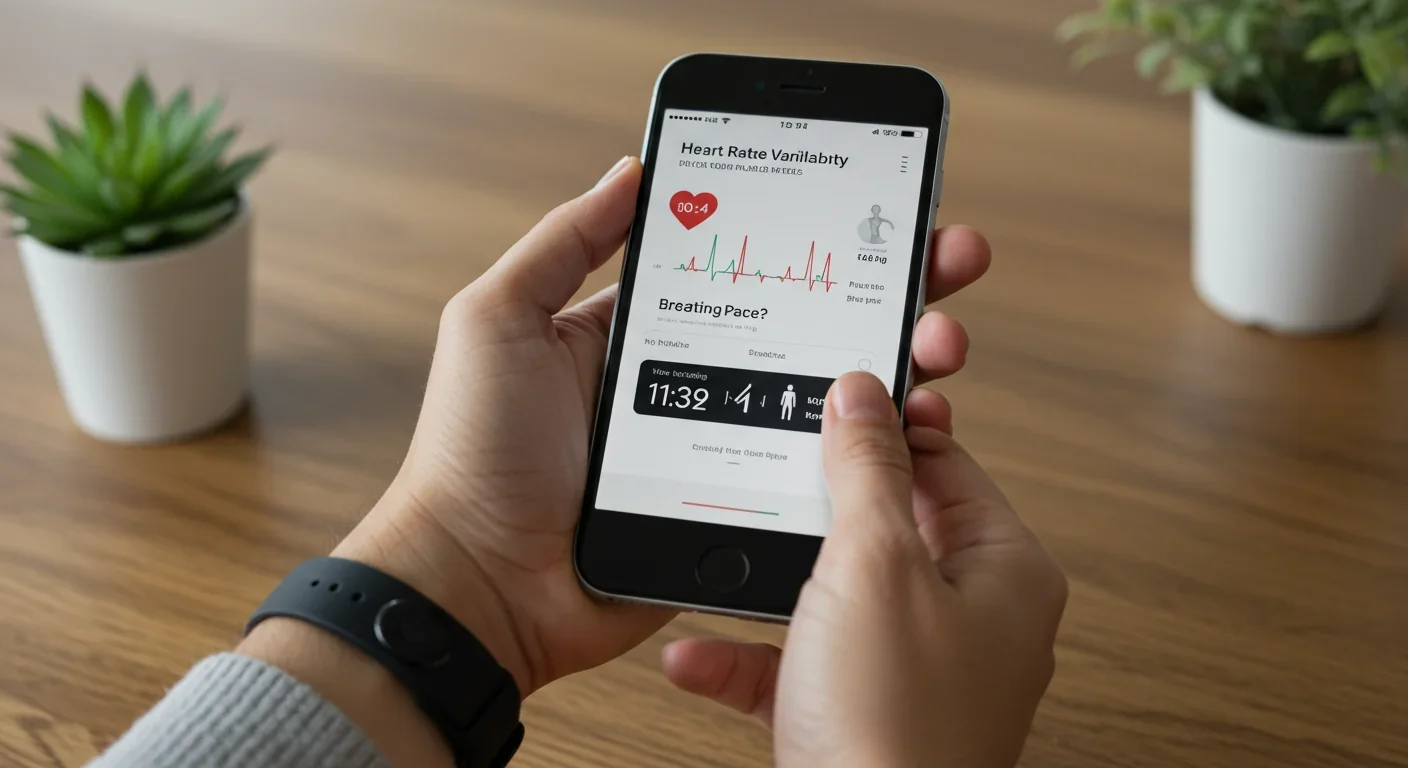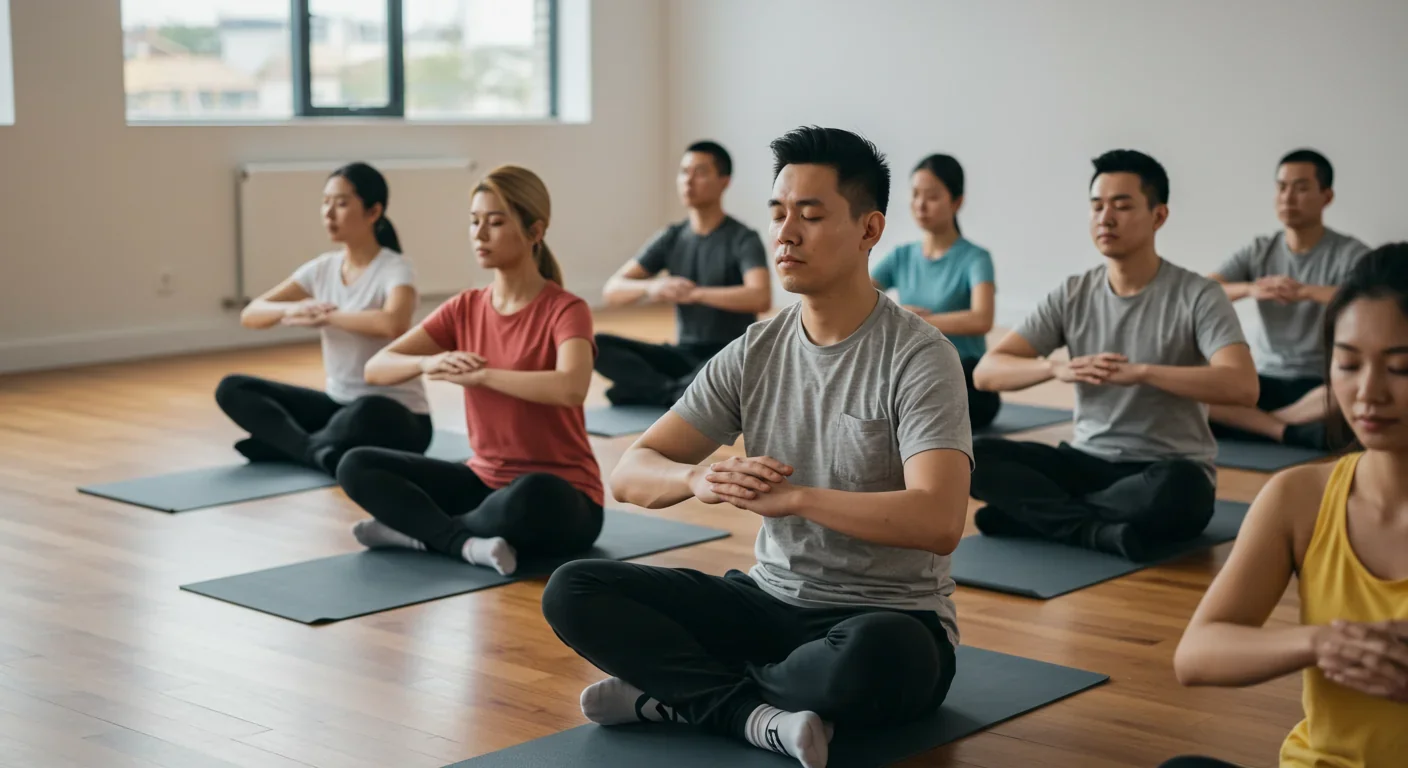Epigenetic Clocks Predict Disease 30 Years Early

TL;DR: Controlled breathing directly influences your autonomic nervous system, heart rate variability, and stress response through measurable physiological changes. Research shows simple techniques like box breathing and coherent breathing can reduce cortisol, boost HRV, and improve focus in just minutes a day.

Take a slow breath in. Hold it for a moment. Now let it out. In those few seconds, you just influenced your heart rate, blood pressure, stress hormones, and even your brain waves. It sounds too simple to be true, but the science is clear: the way you breathe shapes your biology in ways we're only beginning to understand.
For most of us, breathing is background noise—something that happens while we're busy doing other things. But researchers are discovering that this automatic function is also a direct line to your autonomic nervous system, the command center that controls everything from your heart rate to your immune response. And unlike most bodily functions, breathing is something you can actually control.
At the heart of breathwork's power sits the vagus nerve, a wandering bundle of fibers that connects your brain to nearly every major organ. Think of it as your body's information superhighway, carrying signals between your brain and your heart, lungs, digestive system, and immune cells.
When you take a slow, deep breath, you're not just filling your lungs—you're sending a message through this nerve that ripples across your entire system. The vagus nerve responds to breathing patterns by modulating what scientists call your "autonomic tone." Slow breathing activates the parasympathetic branch (rest-and-digest mode), while rapid breathing fires up the sympathetic side (fight-or-flight).
What makes this fascinating is that the relationship works both ways. Your emotional state affects your breathing, but your breathing also shapes your emotional state. When you deliberately slow your breath, you're essentially telling your brain that everything's okay, even if your thoughts are racing.
One of the most measurable effects of breathwork shows up in something called heart rate variability, or HRV. Despite the name, HRV isn't about your heart rate itself—it's about the tiny fluctuations in time between each heartbeat.
A healthy heart doesn't beat like a metronome. Instead, the time between beats varies slightly with each breath. You inhale, your heart speeds up. You exhale, it slows down. This natural rhythm, called respiratory sinus arrhythmia, is actually a sign of a healthy, responsive nervous system.
Research shows that breathing-based interventions consistently increase HRV, which is associated with better stress resilience, improved emotional regulation, and even longevity. In one study of manufacturing workers, just five weekly sessions of HRV-biofeedback with breathing training produced significant reductions in cortisol and improvements in HRV parameters.
The beauty of HRV is that you can measure it. Wearable devices and smartphone apps now let you track how your breathing practice affects your autonomic tone in real time, turning an invisible physiological process into tangible feedback.
Here's where breathwork gets counterintuitive: sometimes the goal isn't to breathe more oxygen in, but to keep more carbon dioxide in.
Most people think of CO₂ as waste—something to get rid of with every exhale. But carbon dioxide plays a crucial role in regulating your breathing rate and determining how efficiently your blood delivers oxygen to your tissues. When you breathe too quickly or too shallowly, you can actually blow off too much CO₂, which triggers a cascade of problems: reduced oxygen delivery, increased anxiety, and a shift toward sympathetic dominance.
This is why slow, controlled breathing techniques work so well. By extending your exhales and pausing between breaths, you maintain higher CO₂ levels, which paradoxically helps your body use oxygen more efficiently. It's one reason why practices like box breathing—four counts in, hold for four, four counts out, hold for four—can produce measurable drops in heart rate and cortisol after just a few minutes.
Interestingly, patients with chronic hyperventilation can now use CO₂ capnographs to measure their breathing patterns objectively and learn to shift toward slower diaphragmatic breathing that normalizes their HRV.

Not all breathing techniques do the same thing—and that's the point. Depending on what you're trying to accomplish, you can choose a practice that either calms you down or revs you up.
Slow breathing techniques like ujjayi breath (used in yoga) enhance parasympathetic tone and promote relaxation. Research comparing four yogic breathing techniques found that slow breathing consistently boosted mindfulness and reduced stress.
Fast breathing methods like kapalabhati (skull-shining breath) or the Wim Hof method work differently. These techniques involve rapid, forceful breaths followed by breath holds. They activate the sympathetic nervous system, increase alertness, and may even trigger the release of adrenaline and immune-boosting compounds.
Coherent breathing aims for a sweet spot: typically 5-6 breaths per minute for most people (though ideal rates vary by height—taller individuals do better at 3-4.5 breaths per minute). At this rate, your heart rate, blood pressure, and breath synchronize into a coherent pattern that maximizes HRV and vagal tone.
Nasal breathing deserves special mention. Breathing through your nose rather than your mouth activates different reflexes, filters and warms incoming air, and produces nitric oxide—a molecule that dilates blood vessels and improves oxygen uptake. Athletes are increasingly training themselves to maintain nasal breathing even during moderate-intensity exercise, though mouth breathing remains necessary during maximal effort.
The connection between breathing and mental state goes deeper than stress relief. Recent research shows that breathing patterns directly influence brain waves and cognitive function through bidirectional coupling between the autonomic nervous system and cortical activity.
What this means in practice: you can use targeted breathing to intentionally adjust your mental state. Need to focus? Try box breathing. Feeling sluggish? A few rounds of rapid breathing might help. Overwhelmed? Slow, diaphragmatic breaths can shift your brain into a calmer, more receptive mode.
This isn't just subjective experience—it shows up in measurable changes in EEG patterns and attentional performance. The ability to modulate your autonomic tone through breathing gives you a kind of remote control for your mental state.
The research is compelling, but does breathwork actually work in real-world settings? Increasingly, yes.
A systematic review of workplace biofeedback interventions found that breathing-based programs consistently reduced stress, anxiety, and depressive symptoms. Eight out of nine studies reported positive outcomes, with mobile app-delivered breathing programs showing results comparable to traditional in-person biofeedback.
The key seems to be consistency over intensity. Short, daily five-minute sessions proved more effective than longer, less frequent protocols. When psychiatric ward nurses used a smartphone breathing app for six weeks, they showed significant reductions in depressive symptoms, improvements in resilience, and lower occupational stress.
For athletes, respiratory muscle training serves as a bridge between conscious breathing practice and systemic autonomic regulation. Studies show improvements not just in respiratory endurance but also cardiovascular function and psychological well-being.
Even practices like Tai Chi demonstrate breathwork's power through a different lens. Research on Tai Chi practitioners shows that those who emphasize mindfulness during practice develop higher baseline parasympathetic tone—not just during the practice itself, but as a lasting adaptation.
Breathing isn't the only way to stimulate your vagus nerve, though it might be the most accessible. Cold exposure triggers the mammalian diving reflex, which slows heart rate and causes vasoconstriction, followed by a parasympathetic rebound. Some practitioners combine cold showers with controlled breathing for a double dose of vagal stimulation.
Humming, chanting, and singing also activate the vagus nerve through vibrations in the throat and chest. The same goes for laughter, social connection, and even gratitude journaling—all provide diverse pathways to engage the parasympathetic system.
What ties these practices together isn't the specific technique but the underlying principle: small, intentional actions can shift your autonomic balance, with effects that cascade through your entire physiology.

It's worth noting that breathwork isn't a cure-all. One 12-week study of slow breathing for blood pressure reduction found that while blood pressure dropped, HRV didn't change significantly—suggesting that long-term slow breathing may work through mechanisms other than autonomic modulation, such as changes in endothelial function or kidney fluid regulation.
The takeaway isn't that breathing doesn't work, but that the body is more complex than any single intervention can address. Breathwork is a tool, not a magic solution.
If you want to experiment with breathwork, here are four techniques backed by research, each with different effects:
1. Box Breathing (for focus and stress relief)
• Inhale through your nose for 4 counts
• Hold for 4 counts
• Exhale through your nose for 4 counts
• Hold empty for 4 counts
• Repeat for 5-10 minutes
Start with this in the morning or before high-stress situations. Even a few minutes can lower heart rate and reduce cortisol.
2. Coherent Breathing (for HRV and balance)
• Breathe in for 5 seconds
• Breathe out for 5 seconds
• Continue for 10-20 minutes
This creates a rhythm of about 6 breaths per minute, which tends to maximize HRV. If you're taller than six feet, try 4 breaths per minute instead.
3. Physiological Sigh (for quick stress reset)
• Take a deep breath in through your nose
• Without exhaling, take another shorter breath in
• Exhale slowly and completely through your mouth
• Repeat 1-3 times
This pattern, which occurs naturally when you're stressed, works even better when you do it intentionally.
4. Nasal Breathing (for everyday baseline)
• Simply breathe through your nose throughout the day
• If you currently mouth-breathe, start practicing nasal breathing at rest, then during walking, then during light exercise
• Never force nasal breathing during high-intensity effort
Track your practice with any HRV-capable wearable or smartphone app to see how your autonomic tone responds. Most people notice changes within 2-4 weeks of consistent practice.
We're living through a fascinating moment where ancient breathing practices are meeting modern measurement technology. Wearables can now provide real-time feedback on HRV, respiratory rate, and autonomic balance. Smartphone apps deliver guided breathing programs that rival clinical interventions.
This convergence means you no longer need to take breathwork on faith—you can see its effects in your own data. And as the research expands, we're discovering new applications: from managing chronic pain to enhancing athletic performance to supporting recovery from PTSD.
The next frontier involves personalization. Just as the optimal breathing rate varies by height and individual physiology, the most effective technique probably varies by person, context, and goal. As measurement tools improve, we'll likely see increasingly tailored breathwork protocols based on your unique autonomic signature.
The science of breathwork reveals something profound: you have more control over your biology than you might think. The autonomic nervous system isn't as automatic as its name suggests. Through conscious breathing, you can influence processes that usually run on autopilot—your heart rate, blood pressure, immune function, stress response, and even your mental state.
What makes this remarkable isn't just that it works, but that it's so accessible. You don't need special equipment, a gym membership, or a prescription. You just need a few minutes and the willingness to pay attention to something you've been doing unconsciously your entire life.
The breath you just took while reading this? That was an opportunity. So is the next one.
Start there.

Recent breakthroughs in fusion technology—including 351,000-gauss magnetic fields, AI-driven plasma diagnostics, and net energy gain at the National Ignition Facility—are transforming fusion propulsion from science fiction to engineering frontier. Scientists now have a realistic pathway to accelerate spacecraft to 10% of light speed, enabling a 43-year journey to Alpha Centauri. While challenges remain in miniaturization, neutron management, and sustained operation, the physics barriers have ...

Epigenetic clocks measure DNA methylation patterns to calculate biological age, which predicts disease risk up to 30 years before symptoms appear. Landmark studies show that accelerated epigenetic aging forecasts cardiovascular disease, diabetes, and neurodegeneration with remarkable accuracy. Lifestyle interventions—Mediterranean diet, structured exercise, quality sleep, stress management—can measurably reverse biological aging, reducing epigenetic age by 1-2 years within months. Commercial ...

Data centers consumed 415 terawatt-hours of electricity in 2024 and will nearly double that by 2030, driven by AI's insatiable energy appetite. Despite tech giants' renewable pledges, actual emissions are up to 662% higher than reported due to accounting loopholes. A digital pollution tax—similar to Europe's carbon border tariff—could finally force the industry to invest in efficiency technologies like liquid cooling, waste heat recovery, and time-matched renewable power, transforming volunta...

Humans are hardwired to see invisible agents—gods, ghosts, conspiracies—thanks to the Hyperactive Agency Detection Device (HADD), an evolutionary survival mechanism that favored false alarms over fatal misses. This cognitive bias, rooted in brain regions like the temporoparietal junction and medial prefrontal cortex, generates religious beliefs, animistic worldviews, and conspiracy theories across all cultures. Understanding HADD doesn't eliminate belief, but it helps us recognize when our pa...

The bombardier beetle has perfected a chemical defense system that human engineers are still trying to replicate: a two-chamber micro-combustion engine that mixes hydroquinone and hydrogen peroxide to create explosive 100°C sprays at up to 500 pulses per second, aimed with 270-degree precision. This tiny insect's biochemical marvel is inspiring revolutionary technologies in aerospace propulsion, pharmaceutical delivery, and fire suppression. By 2030, beetle-inspired systems could position sat...

The U.S. faces a catastrophic care worker shortage driven by poverty-level wages, overwhelming burnout, and systemic undervaluation. With 99% of nursing homes hiring and 9.7 million openings projected by 2034, the crisis threatens patient safety, family stability, and economic productivity. Evidence-based solutions—wage reforms, streamlined training, technology integration, and policy enforcement—exist and work, but require sustained political will and cultural recognition that caregiving is ...

Every major AI model was trained on copyrighted text scraped without permission, triggering billion-dollar lawsuits and forcing a reckoning between innovation and creator rights. The future depends on finding balance between transformative AI development and fair compensation for the people whose work fuels it.